How Automotive Customer Service is Flourishing in The Digital World
It’s time to face the facts; buying a new car isn’t something people do on a whim. It’s an important decision made on a big-ticket item that could potentially last for years, and customers are understandably concerned about getting it right. In fact, research has shown that car purchasing decisions can be influenced by up to 900 different touchpoints!
Plus, we haven’t even explored how the expansion of the digital medium can influence and affect the overall customer journey, with review sites and personal experiences dominating the Internet and leaving potential buyers with more information than ever.
Image from: TOC Automotive College (How Automotive Customer Service is Flourishing in The Digital World)
Still, this is part of a broader pattern of shifting automotive industry trends, where millennials are the biggest driving force and demographic in terms of car purchases for the foreseeable future. Adapting to their needs and their behavior will depend greatly on providing them with the best customer service possible.
There are three key points in how customer service should be run within the automotive industry.
1. Defining a common purpose
There is a need to define a common purpose within customer service and experience, from the management to the frontliners. This will ensure that your direction is aligned and reach out to customers on all touchpoints.
2. Analysis of the customer journey
Buying a car is often a long process, and undergoes several different touchpoints. It is important to note how essential it is to analyze this path in an omni-channel way, to be in the right place, at the right time, and with tailored communication.
3. Personalization & customer loyalty
Customer loyalty is extremely important, as more often than not, it will affect the brand loyalty of several generations. To ensure the retention of a customer, it is essential to know more about the customer as an individual. It may be complex, but it brings great possibilities for the future.
Image from: Majorel (How Automotive Customer Service is Flourishing in The Digital World)
Success in the automotive industry was traditionally seen as a consequence of a superior product. However, superior products are no longer enough. WIthout using product as the main differentiator, customer experience is the new king. So, if you’re set on creating a top-notch customer experience for the modern consumer, take on board these five automotive industry trends.
1. Customers expect omnichannel buying experiences
Although research has become much easier thanks to the internet, customers now expect omnichannel experiences across multiple touchpoints, being able to seamlessly integrate digital and in-store experiences – all the way through to purchase.
Image from: Red Kap (How Automotive Customer Service is Flourishing in The Digital World)
2. Digital content has become essential
Automotive shoppers spend an average of 14 hours researching cars online before making a purchase decision. In total, 61%of their vehicle shopping time is spent online. So ensuring it’s easy for customers to conduct in-depth research makes total sense. It’s not just the car itself customers are researching, it’s help and advice for loans and insurance as well.
For example, Honda provides ‘test view drives’ videos which gives customers an up-close and personal experience of driving their cars by filming from the driver’s perspective. Viewers feel like they are there. This immersive content, paired with key product information, is very effective at creating engagement.
3. Mobility is changing ownership patterns
Revenues from mobility services on the other hand – more flexible models based on needs – According to research by PwC, more than one in three kilometres driven could involve sharing by 2030. This reflects the shift in attitude towards cars, from status symbols, to simply a way to get from one place to another. Privately owned transportation, especially by the younger generations, is slowly being replaced in favor of mobility solutions like ride-sharing, subscription models, or even rental services.
So, how can you go about harnessing these new automotive industry trends?
Image from: EU Business News (How Automotive Customer Service is Flourishing in The Digital World)
As an automotive brand, you need to find ways to incorporate these trends into your overall strategies to stay relevant in future. These include:
Identify and digitize key customer touch points.
Establish an effective customer feedback process.
Experiment with new customer experience ideas.
Leverage content and tech.
Look beyond the sale
Conclusion
For an industry as huge as automotive, with its complex and typically slower sales dynamics, customer service is important. When it takes, on average, around 15 hours to purchase a car, this is where loyalty is built. It’s easier to sell a new car to a customer who has already had a satisfactory experience with the brand and the dealer.
What did you think about our article? Share your thoughts in the comments below!
If you’ve always wanted to explore a career in automotive, motorsports, and all things related, why not check out our various programmes and courses available at TOC? We are one of the best automotive colleges in Malaysia that provides you with the education pathway you need to turn your dream into reality!
Image from: TOC Automotive College (How Automotive Customer Service is Flourishing in The Digital World)
If you’d like to know more about the automotive industry or if you’re still unsure whether it would be a good fit for you, don’t hesitate to have a chat with our automotive course counsellors, who would be happy to help you out!





